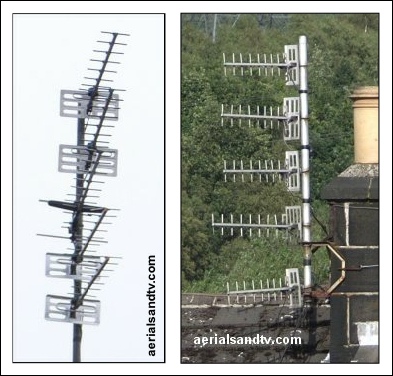Aerial splitters
Subject list :
Aerial splitters : basics
Splitter or amplifier ?
Splitter losses
Impedance matched system
Power pass (for a mast head amp)
"Head End Amplifiers”
Internal splitters
External splitters
Typical uses of splitters
More than one TV aerial on your house ?
Splitting the signal from a satellite dish
And finally, avoid this crap.
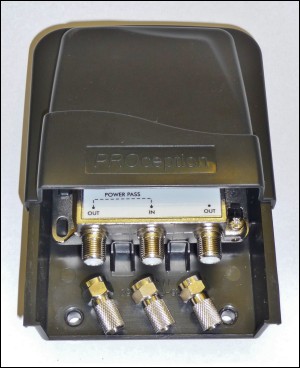
Aerial splitters : general information (also see Taps)
As the name suggests splitters are used to "split" the signal from the aerial to feed multiple points. If your signal strength allows it I would generally advise the use of a splitter over an amplifier because it is simpler, cheaper, more reliable, introduces less noise and is less likely to give cross modulation problems. The latter was quite significant at DSO (2008 to 2012) when the power of the transmissions was increased markedly.
If undertaking a new installation using a splitter I’d temporarily fit the aerial to just one point. Check you receive all the channels reliably, preferably over a few days. Then add the splitter. If the signal continues to be reliable then Bingo, it’s done. On the other hand if the signal becomes problematic after putting the splitter in the circuit you then at least know that pre-amplifying the signal before the splitter (or swapping the splitter for an amp) will result in a working system. If fitting a splitter it is a very good idea to buy a B to B F connector, these are cheap and easily facilitate bypassing the splitter.
If you use a splitter but discover an unacceptable fall off in signal, you can always add an amplifier in front of it, a 1 way mains type like this one for internal splits (near a mains plug), or a 1 way Mast Head amp for external splits or where there’s no mains plug [e.g. In the loft].
Thus, the moral of the above story is, if you’re unsure whether to fit a (passive) splitter or an amplifier/"booster" [i.e. an amplified splitter] I’d go with a splitter because you always have the option to add a one way amp in front of it if required *.
On the other hand, you can’t remove the amplifier part of the amplified splitter ! ? !
* This one way amp is particularly suitable as it has a high maximum input level, switchable (high/low) gain and accepts TV, FM & DAB (handy if you have them combined in with the TV signal).
See these very useful and interesting customer feedback reports on splitters v amplifiers.
It should always be remembered that it is the splitter (and the cables from it) which represent the load on the signal, it is irrelevant whether or not there is a TV on the end.
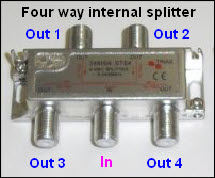
The loss through a 2 way splitter is about 3 to 4 dB (for UHF) and most locations can accommodate this with no problems, in fact if you have decent signals even a four way (or even an 8 way) should be fine. Remember you are only losing signal level, the quality should be exactly the same on the split signal. If you use a splitter and then find unacceptable signal degradation it’s fine to just add an amplifier before the input to the splitter. Note that for some CoAx splitters it does matter which way round they’re fitted !
Loss through splitters at UHF :
2 way = 4db 4 way = 8dB 6 way = 10dB 8 way = 12dB
For a 2 way splitter on VHF (FM/DAB) the loss would be about 3dB.
For a 2 way split at satellite IF the loss would be about 5dB at 1MHz (the bottom of the IF frequency range) and 6dB at 2GHz (the top of the IF frequency range), though, in fact, you cannot easily split a satellite signal anyway.
A splitter should always be used because just "splicing" the aerial downleads together is very bad practice from both weather proofing considerations (if it’s mounted outside) and the signal point of view. Aerial splitters are designed to maintain a 75Ω (Ohm) "impedance matched system", this maximises signal transfer and minimises the chances of reflections of the signal back up the cable. All TV tuners are designed to work with a 75Ω load, all TV cable should be 75Ω and all decent aerials are designed to have (as close as possible) a 75Ω impedance at the dipole or balun. Other bodges include using a plain junction box of the type utilised for mains wiring (not that they’re screened anyway, so that’s a particularly big no no) or fitting a "one in two out" budget wallplate plate. Also see 50 Ohm / 75 Ohm impedance mismatch loss.
Bodging 2 cables into one aerial like this destroys what should be an impedance matched system. Any installer who connects two cables to an aerial without a splitter (or who uses an "insulation tape splitter") should get back to “The OK Corral” and do some cowboying there, and you can quote me on that. The pictures (and the graphic below) show how it should be done.
Having said all of the above, as I have repeatedly stated on this site, if you live in a strong signal area (or are just plain lucky), bodges may well work, up to a point anyway, for instance, you may just get more intermittent interference. We can only advise you of best practice and then it’s up to you.
Note : beware of cheap crappy splitters......
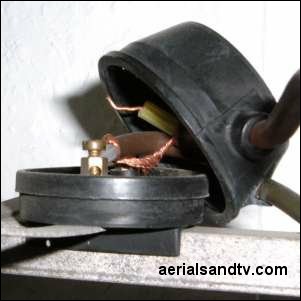
Using a splitter will obviously only supply a proportion of the signal out of each leg, but so long as an adequate signal is present at the input, it is quite acceptable to split the signal 2, 3 or 4 times. In fact in strong signal areas unamplified signals can be split up to eight ways (or more) with no problem at all, see actual signal levels and how many points can be run withjust a splitter. The crucial point is that there is still at least 45dBμV of digital signal at each TV tuner input.
If it is more convenient, a powerful one way masthead amp can be used as a “head end amp” and the signal then split where it is required. If using the latter technique remember that power pass (enabling the 12V for the masthead amp to pass through the splitter to the M/H amp) considerations must be satisfied. All the splitters we sell (except the Co Ax splitter) enable power pass.
If using a “head end amplifier” with the splitter located at a more convenient location one can work out the nett amplification quite simply by taking the dB loss of the splitter from the dB gain of the amplifier. For example if one uses a 22dB gain Mast Head amp feeding a 6 way splitter (with a loss per output of 10dB) one still has a nett amplification of 12dB. Large commercial systems use the same principle to feed up to 100 points (or more) by using launch amps with very high gain (e.g. 35dB) feeding splitters and/or taps. Even using a relatively small head end amp of say 35dB one could feed an 8 way splitter (loss 12dB) which could then feed 8 more 8 way splitters (at another loss of 12db) which still gives a nett gain of 11dB (less cable loss) at each output. And that’s for 64 points !
Indoor splitters (available in 2 way, 4 way, 6 way and 8 way).
All our splitters are high quality screened and any F connectors required with our splitters (or amps) are included in the price, and they’re decent ones !
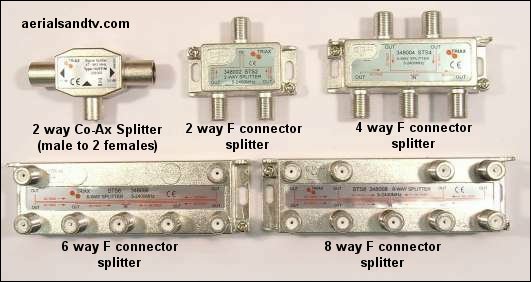
External (mast head type) splitters (available here in 2 and 4 way) are equally suitable for mounting on the wall or the aerial mast according to which is more convenient.
If mounting a splitter on the wall and tapping into a pre-existing downlead you should bear in mind the cable you’re splitting off from will need some slack in it for the cable to divert over and into (then out of) the bottom of the splitter. If you don’t have any slack use a cable joint kit to add additional cable as required.
All the mast head products we stock come with a strap (to attach to the mast) but personally I’d always tape them on as well, just in case the tie wrap breaks. After all, going up there to replace the tie wrap is a PITA, and if the splitter ends up upside down it'll fill with water.....
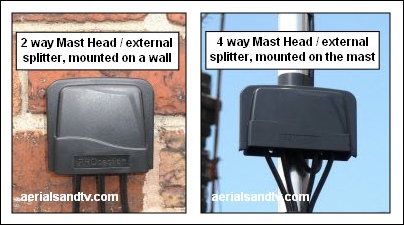
Typical uses of internal and external splitters :
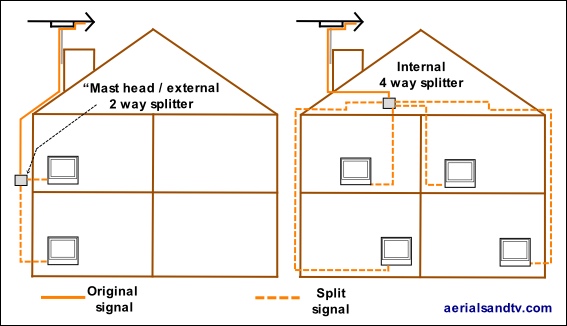
Unless two antennas of different groups are required to obtain good signals (and this is very rare*) you do not need to have more than one TV aerial on your house. It’s obvious if you think about it. If you couldn’t run more than one TV off each aerial then the size of tower blocks would be limited by the number of aerials they could fit on the roof….. Not only do multiple aerials look a bit of a mess but there will be greatly increased wind loading as well. Only one antenna is needed to feed multiple points through either a splitter or amp as required (usually the former is all that's required). In fact if a large enough amplifier is used you can feed a hundred TVs from one aerial (this is not applicable to simple satellite systems).
* It’s very rare to require two aerials on the same transmitter, though it’s slightly less rare to have two aerials on two different transmitters, often diplexed together. This may be to receive different local news or because the different transmitters give better signals on different channels.
I know that looks are subjective but I feel I would be on pretty safe ground if I were to say that these installs were “aesthetically challenged”.
As revealed in the paragraph, it is not necessary to have carbuncles such as these on your house when the use of a splitter or amp would obviate it.
Note the crappy contract aerials.......
